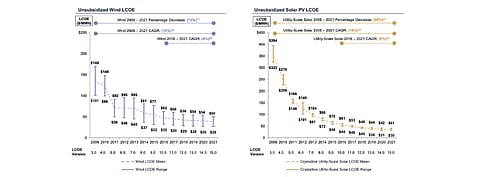

Even as certain renewable energy technologies continue to be cost competitive, including utility scale solar, global financial advisory and asset management firm Lazard Ltd sees growing upward pressure on project capital costs for facilities reaching commercial operation in 2021.
Power Generation
In its annual publication Levelized Cost of Energy Analysis (LCOE) 15.0, Lazard said it is seeing rates of decline in the LCOE for onshore wind and utility scale solar to have slowed down in recent years, yet continued to decline thanks to reductions in capital costs, increased competition and continued improvements in scale and technology… an observation it shared in the LCOE 14.0 (see Lazard Releases Levelized Cost Of Energy Analysis 14.0).
The pace of decline for utility scale solar continues to be greater than that for onshore wind. The authors explain it as 5-year compound annual declines of 8% in the average LCOE of utility-scale solar, compared to 4% for onshore wind.
Including the US government subsidies, the cost of onshore wind at an average of $25.00 per MWh, and utility scale solar with $27.00 per MWh continues to be cost competitive with the marginal cost of coal ($42.00 per MWh), nuclear ($29.00 per MWh) and combined cycle gas generation ($24.00 per MWh).
In 2021, the projects that start commercial operations reflect these declining costs. However, there is a growing upward pressure on project capital costs due to commodity cost inflation, supply chain disruption and increasing demand for renewable energy generation capacity. Rising capital costs could all lead to higher LCOE in the future.
Energy Storage
Analysts see YoY changes in the cost of storage as mixed across use cases and technologies, 'driven in part by the confluence of emerging supply chain constraints and shifting preferences in battery chemistry' in the 7th edition of the Levelized Cost of Storage Analysis 7.0 . There is a growing preference for lithium-iron-phosphate (LFP) due to its lower cost vis-à-vis lithium-ion technologies.
They also see grid operators adopting Estimated Load Carry Capability (ELCC) method as driving increasing deployment of hybrid resources to mitigate resource intermittency.
Hydrogen
Releasing its 2nd edition of the Levelized Cost of Hydrogen Analysis 2.0 , Lazard sees cost of hydrogen as still heavily dependent on the cost and availability of the energy resources required to produce it. Analysts opines that there would be faster cost competitiveness achieved by those hydrogen applications that require minimal additional steps of conversion, storage and transportation, than those that require greater site or application specific investments.
They count cost of electricity, capital expenditures for production equipment and electrolyzers as key drivers for hydrogen's LCOE.
"We're also seeing that the transition will not be dominated by any one solution — rather a new 'all of the above' approach, which includes renewable energy, storage, hydrogen and other solutions, will be key to effecting the permanent shift to increased energy efficiency and sustainability," said Vice Chairman and Global Head of Lazard's Power, Energy & Infrastructure Group George Bilicic.
.png?w=50&fm=png)